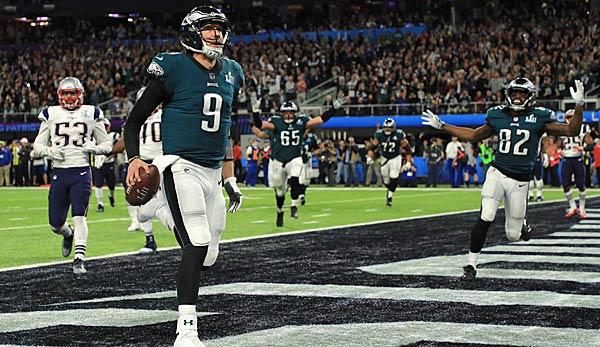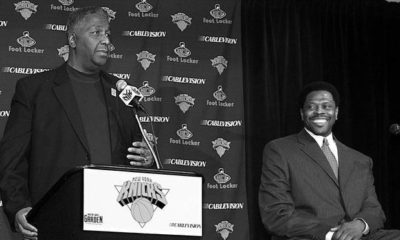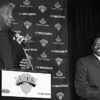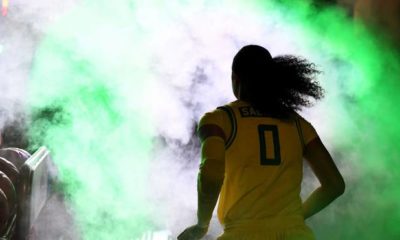US-Sport
NFL: Third and Long: How did Philly’s Super Bowl Coup succeed?
Super Bowl 52 had an unexpected course, with an unexpected exit. How could the Philadelphia Eagles do a shootout against Tom Brady and Co. win? Which layouts marked the way there? What happened to Malcolm Butler? What’s gonna happen to Nick Foles? And was it actually a good Super Bowl? SPOX editor Adrian Franke looks back in his weekly NFL column.
You also want to ask questions to the SPOX-NFL column? This goes directly to the author!
Play number 1: Target left Bunch, Philly Special
In my follow-up to the Eagles, I had already focused on that: A central reason for the Eagles’ victory was the courage of Head Coach Doug Pederson, who held on to his own aggressive line and did not let himself be impressed by the stage, the moment or the opponent. Many coaches can learn from this. The Eagles had already played 26 Fourth Downs in the regular season, 17 of which were successful. The second-highest or highest value in the NFL this season.
The procedure was already clear when Pederson took a risk with the second touchdown – the 21 yard run by Blount – and tried to compensate for the PAT shot at the first touchdown with a 2-point conversion. And it was 38 seconds before half-time when Philly could have increased his lead to six points at Fourth Down, one and a half yards ahead of New England’s final zone via Field Goal. But Pederson decided otherwise.
Four plays marked the Super Bowl triumph of the Eagles over New England. This was the first one from the quartet.
It’s a play that demands a certain acting talent from the quarterback:”Target left Bunch, Philly Special” is the title of the Eagles’ playbook. The quarterback has to make it look like he’s announcing changes to the line of scrimmage and therefore leaving his position in the backfield. The direct snap then goes to the running back, which passes to a receiver that runs inwards from the side.
Several misdirection elements have already been created – and most of the defenses forget about the quarterback as soon as the snap takes place and it is a little lost in the room.”We’re talking about Fourth Down here. Philadelphia has never won a Super Bowl before. And he’s got a pass to quarterback? Was there ever a play call like that in the Super Bowl?”, Tight End grinned at Trey Burton, who had thrown the pass, afterwards.
Pederson had told offensive coordinator Frank Reich the day before the Super Bowl, according to the MMQB, that he would come back to this play in the course of the game and told Reich that assistant coach Press Taylor – known internally for his wide range of trick moves – had discovered the play.
Pederson and his trainer staff are always on the lookout for plays that have worked elsewhere and can be adopted. It is no coincidence that Pederson’s Offense makes full use of elements such as the mesh-wheel combination in addition to the Run Pass options. Building blocks that are best known from the offense of Pederson’s predecessor in Philadelphia, Chip Kelly.
It’s not the first time you’ve seen this trick play on an NFL field either: The Chicago Bears used the exact same play in the same stadium and in the same end zone, for example, in the regular-season game against Minnesota in the penultimate season.
Nick Foles himself had already played the game in high school (!). And, perhaps the most interesting twist: The Patriots themselves had played this play in the regular-season duel with the Eagles 2015. It’s a Copycat League.
At first glance, the line-up looked like an illegal formation – but that was not the case. Read more about this in the reader questions.
Play number 2: The Clement-Touchdown in the 3rd. neighborhood
The first Eagles drive after the half-time break was absolutely critical. New England came out of the cabin with fire as expected, Gronkowski was the center of the first drive in the third quarter and the patches were in the final zone after 2:45 minutes and had shortened to 19:22.
Now the right answer of the Eagles was monumentally important. And that came: An 11-Play-Drive for about five minutes, with two Third-Down-Conversions and the 22-yard-Touchdown-Pass on Clement at 3rd&6.
The second third down was already a Pederson play-calling dream: At 3rd&1 he sent out a heavy formation with an additional O-liner and two tight ends. From this came the play-action fake with chip blocks (a short block before you start your route) of both tight ends – almost every defender expects a run at this point. From there both tight ends overloaded the right side, Ertz was free for the 22-yard pass.
The touchdown pass itself – although I’m still not personally convinced that Clement controlled the ball; but who knows what a catch is – was also perfectly designed: two wide receivers on the right-hand side draw attention to themselves, while on the left-hand side, where the play is supposed to go, inside-routes are run.
The deeper route through the tight end pulls the safety away just long enough so that Clement actually gets the matchup with the linebacker. Nevertheless, it needed a perfect passport from Foles, which should not go unmentioned.
Clement was an X-factor in the game, and this was particularly surprising as New England had already revealed some problems two weeks earlier against Jacksonville’s Corey Grant, whom the Jags had used similarly, but still lacked concrete adjustments. 21 offensive snaps played Clement, with the Eagles reaching 203 yards and 9.3 yards per play as well as three touchdowns.
Play number 3: The Fourth Down in the 4th. neighborhood
With 5:39 minutes on the clock and 4th&1 from his own 45-yard line, Pederson’s aggressiveness was called for once again. The Eagles could have played here – and not a few coaches would have done it. With enough timeouts we hope that the Defense will make a stop after all and that you have the final drive in return.
Fortunately for the Eagles, Pederson thought otherwise.
Philadelphia had considered heavy formations as one approach for the Super Bowl – six offensive linemen (as seen before the clearing touchdown) or about 3-TE sets. In the regular season, Philly played such formations at just under five percent of her snaps with three yards per play. In the Super Bowl? 14 percent of snaps with six (!) yards per play. The Eagles could use these formations for run-blocking and play-action.
This formation was also the beginning of the critical fourth-quarter Fourth-Down-Play, which finally paved the way for the decisive touchdown: Two tight ends (Burton, Kelce) on the left, with Ertz a third tight end on the right. Burton and Kelce are the Rub-Route players who besiege the middle of the field.
Ertz runs in the shadows of an Underneath route, so that his opponent cannot follow him. The safety, in the case Harmon, comes back to the line sprinted, but is too late for the decisive split second and can’t prevent the 2-yard-catch to the new first down.
On the one hand, such play designs are a huge help for the quarterback, who knows exactly where a player should be free. They also allow to be aggressive.
Play number 4: The strip sack by Brandon Graham
Like most people, I was convinced that the Eagles would have to dominate the game over the defensive line. Inside-Pressure without Blitzing, ideally combined with brave man coverage behind it – this seemed the best recipe to cause Brady problems and stop New England’s attack as often as possible. Philly was in an excellent position to do so. In theory, anyway.
With Fletcher Cox, Brandon Graham, Vinny Curry, Timmy Jernigan, Derek Barnett and Chris Long, the depth of the Defensive Line should be just like the quality of the keys to victory. However, for a long time there was hardly anything to see.
With the exception of individual phases, Philadelphia created far too little pressure on Brady, the combination of 4-men rush and passive coverage led to the fact that Brady was not able to integrate the running backs as well as usual – but instead found constant gaps in the deep-passing game even without brand-in cooks.
Up to the only really decisive defense big play in this year’s Super Bowl.
It was the first time in this game that Schwartz’s approach of 4-men-rush and off-coverage – to which he had frighteningly few meaningful alternatives at his fingertips – brought real success: Graham from the defensive tackle position got enough time through coverage at 2nd&2 and reached Brady through the middle, knocked the ball out of his hand and thus made the preliminary decision.
In a game in which both defenses had no answers, no adjustments and no alternative ideas for a long time, the team that won the most critical phase of the game was the team that won the game. The Super Bowl was reminiscent of the crazy Packers-Cardinals shootout in the playoffs a few years ago, when Aaron Rodgers and Kurt Warner duelled each other on an insane level – and Arizona won the game with a defensive touchdown in Overtime.
Page 1: Four Plays that marked the Super Bowl victory of the Eagles
Page 2: Foles’ Future, Butlers Degradation, the Problems of Defenses – Your Questions


















You must be logged in to post a comment Login